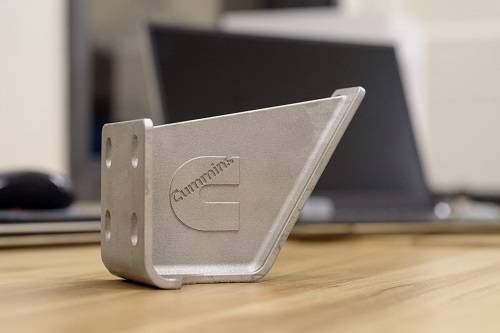Cummins has sold its first metal part printed on one of its own 3D printers, moving the company a significant step closer to the exciting potential of additive manufacturing.
The part was a low-volume bracket for a customer in Cummins’ New and ReCon Parts division and did not have a current supplier. The company is focusing first on printing low-volume parts as it studies how best to use 3D technology in higher volume manufacturing.
“With this technology you can really unshackle the designer to do things you just can’t do using traditional forms of manufacturing,” said Brett Boas, Director-Advanced Manufacturing at the Cummins Technical Center in Columbus, Indiana (U.S.).
Parts can be made lighter, stronger and more effective using metal 3D printing compared to parts created using more traditional methods that employ molds, molten metal and equipment to precisely cut and shape the part.
3D printing creates three-dimensional objects one ultra-thin layer at a time. If the part doesn’t come out quite right, the designer can simply change the computer design file and print it again; a much faster process than using traditional manufacturing techniques to build a test part.
Finally, the technology enables designers to combine multiple parts into one printed object, creating the ideal geometry to avoid potential failures at weldments, gaskets and joint assemblies needed using traditional manufacturing methods.
THE BEGINNING OF A REVOLUTION?
Cummins’ two-pronged strategy for additive manufacturing is part of the company’s take on Industry 4.0, the trend of automation, cloud computing and data driven technology that some call the fourth industrial revolution.
At Cummins, Industry 4.0 includes everything from collaborative robots to artificial intelligence, augmented reality and the enhanced integration between information technologies and manufacturing operations.
The company currently has a metal 3D printer at the Cummins Technical Center in Columbus and three printers at the company’s technical center devoted to aftermarket products in San Luis Potosi, Mexico. Cummins’ operations in San Luis Potosi include a large remanufacturing plant.
Remanufactured engines and parts provide customers with a low-cost option compared to new parts and engines to meet their power needs. They also require far less energy to produce than new parts while keeping products in use and out of landfills.
The tech center at San Luis Potosi only opened in 2017 and the company has already built an addition for the printers. Cummins plans to print parts there that no longer have a supplier or are made on an extremely limited basis.
“This provides an avenue for customers looking for hard-to-find parts,” said Kelly R. Schmitz, Executive Director of New and ReCon Parts Engineering, speaking from San Luis Potosi where he was inspecting the installation of the latest printer. He said metal 3D printing will potentially shave months off the process for customers to get low volume parts.
“The work we are doing in San Luis Potosi will also provide significant learnings as we prepare to leverage metal 3D printing in high volume production,” Schmitz said.
LOOKING AHEAD
Boas is looking at how the printers could work in high-volume settings. He says that will likely mean investing in the next generation of printers. Binder jet printers use an adhesive between powder layers, which can increase printing speed 20 times or more over the printers the company currently owns.
From an environmental perspective, additive manufacturing also means less waste because the cutting required as part of the tool and die process is eliminated. And it could mean fewer resources used for transportation because parts are no longer made in one location and shipped to another.It’s that next generation of technology that could make a seismic change in manufacturing. From a supply chain perspective, it means parts are printed on demand, or closer to demand, so fewer parts would need to be stored for use at manufacturing plants.
Finally, and perhaps most importantly, metal 3D printing enables geometry not possible with traditional methods, creating opportunities to improve product performance.
It becomes significantly easier, for example, to design in weight where it’s needed and take weight out where it’s not, said Dr. Adeola “Addy” Olubamiji, Cummins’ first engineer hired for a full-time position in metal additive manufacturing development. It also means potentially bypassing those connecting parts unavoidable using traditional manufacturing techniques.
When might 3D technology come to high volume manufacturing?
“It’s coming faster than many of us might believe,” Boas said. “I’m thinking as soon as five years. We are at the start of a really interesting time in manufacturing.”


